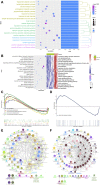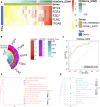Potential effective diagnostic biomarker in patients with primary and metastatic small intestinal neuroendocrine tumors
- PMID: 37091799
- PMCID: PMC10119396
- DOI: 10.3389/fgene.2023.1110396
Potential effective diagnostic biomarker in patients with primary and metastatic small intestinal neuroendocrine tumors
Abstract
Background: Small intestinal neuroendocrine tumors (SI-NETs) are the most common malignant tumors of the small intestine, with many patients presenting with metastases and their incidence increasing. We aimed to find effective diagnostic biomarkers for patients with primary and metastatic SI-NETs that could be applied for clinical diagnosis. Methods: We downloaded GSE65286 (training set) and GSE98894 (test set) from the GEO database and performed differential gene expression analysis to obtain differentially expressed genes (DEGs) and differentially expressed long non-coding RNAs (DElncRNAs). The functions and pathways involved in these genes were further explored by Gene Ontology (GO) and Kyoto Encyclopedia of Genes and Genomes (KEGG) enrichment analyses. In addition, a global regulatory network involving dysregulated genes in SI-NETs was constructed based on RNAInter and TRRUST v2 databases, and the diagnostic power of hub genes was identified by receiver operating characteristic curve (ROC). Results: A total of 2,969 DEGs and DElncRNAs were obtained in the training set. Enrichment analysis revealed that biological processes (BPs) and KEGG pathways were mainly associated with cancer. Based on gene set enrichment analysis (GSEA), we obtained five BPs (cytokinesis, iron ion homeostasis, mucopolysaccharide metabolic process, platelet degranulation and triglyceride metabolic process) and one KEGG pathway (ppar signaling pathway). In addition, the core set of dysregulated genes obtained included MYL9, ITGV8, FGF2, FZD7, and FLNC. The hub genes were upregulated in patients with primary SI-NETs compared to patients with metastatic SI-NETs, which is consistent with the training set. Significantly, the results of ROC analysis showed that the diagnostic power of the hub genes was strong in both the training and test sets. Conclusion: In summary, we constructed a global regulatory network in SI-NETs. In addition, we obtained the hub genes including MYL9, ITGV8, FGF2, FZD7, and FLNC, which may be useful for the diagnosis of patients with primary and metastatic SI-NETs.
Keywords: hub genes; intestinal neuroendocrine tumor; lncRNA; metastatic small intestinal neuroendocrine rumors; primary small intestinal neuroendocrine tumor.
Copyright © 2023 Chen, Meng, Huang, Liao, Tang, Xu and Li.
Conflict of interest statement
The authors declare that the research was conducted in the absence of any commercial or financial relationships that could be construed as a potential conflict of interest.
Figures





Similar articles
-
Expression profiling of small intestinal neuroendocrine tumors identified pathways and gene networks linked to tumorigenesis and metastasis.Biosci Rep. 2020 Jun 26;40(6):BSR20193860. doi: 10.1042/BSR20193860. Biosci Rep. 2020. PMID: 32496505 Free PMC article.
-
A Novel Hypoxia-Related Gene Signature with Strong Predicting Ability in Non-Small-Cell Lung Cancer Identified by Comprehensive Profiling.Int J Genomics. 2022 May 19;2022:8594658. doi: 10.1155/2022/8594658. eCollection 2022. Int J Genomics. 2022. PMID: 35634481 Free PMC article.
-
An integrative bioinformatics analysis of microarray data for identifying hub genes as diagnostic biomarkers of preeclampsia.Biosci Rep. 2019 Sep 3;39(9):BSR20190187. doi: 10.1042/BSR20190187. Print 2019 Sep 30. Biosci Rep. 2019. PMID: 31416885 Free PMC article.
-
Common gene signatures and key pathways in hypopharyngeal and esophageal squamous cell carcinoma: Evidence from bioinformatic analysis.Medicine (Baltimore). 2020 Oct 16;99(42):e22434. doi: 10.1097/MD.0000000000022434. Medicine (Baltimore). 2020. PMID: 33080677 Free PMC article.
-
Surgical aspects of small intestinal neuroendocrine tumors.World J Gastrointest Surg. 2023 Apr 27;15(4):566-577. doi: 10.4240/wjgs.v15.i4.566. World J Gastrointest Surg. 2023. PMID: 37206065 Free PMC article. Review.
Cited by
-
Unveiling the multifaceted role of the FLNC gene: implications for cancer diagnosis and prognosis.Eur J Med Res. 2025 Jul 9;30(1):608. doi: 10.1186/s40001-025-02876-x. Eur J Med Res. 2025. PMID: 40635056 Free PMC article.
-
Small intestinal neuroendocrine tumors lack early genomic drivers, acquire DNA repair defects and harbor hallmarks of low REST expression.Sci Rep. 2025 May 23;15(1):17969. doi: 10.1038/s41598-025-01912-4. Sci Rep. 2025. PMID: 40410286 Free PMC article.
-
Multiomic sequencing of paired primary and metastatic small bowel carcinoids.F1000Res. 2023 Oct 4;12:417. doi: 10.12688/f1000research.130251.2. eCollection 2023. F1000Res. 2023. PMID: 37954063 Free PMC article.
References
-
- Andersson E., Arvidsson Y., Sward C., Hofving T., Wangberg B., Kristiansson E., et al. (2016). Expression profiling of small intestinal neuroendocrine tumors identifies subgroups with clinical relevance, prognostic markers and therapeutic targets. Mod. Pathol. 29 (6), 616–629. 10.1038/modpathol.2016.48 - DOI - PubMed
LinkOut - more resources
Full Text Sources

